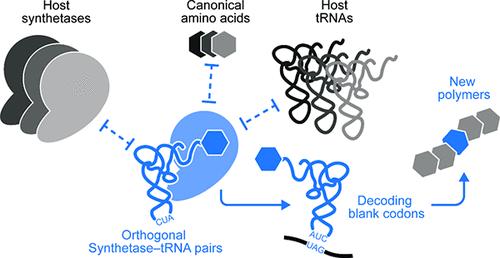当前位置:
X-MOL 学术
›
Chem. Rev.
›
论文详情
Our official English website, www.x-mol.net, welcomes your
feedback! (Note: you will need to create a separate account there.)
Genetic Code Expansion History and Modern Innovations
Chemical Reviews ( IF 51.4 ) Pub Date : 2024-10-28 , DOI: 10.1021/acs.chemrev.4c00275 Alan Costello, Alexander A. Peterson, Pei-Hsin Chen, Rustam Bagirzadeh, David L. Lanster, Ahmed H. Badran
Chemical Reviews ( IF 51.4 ) Pub Date : 2024-10-28 , DOI: 10.1021/acs.chemrev.4c00275 Alan Costello, Alexander A. Peterson, Pei-Hsin Chen, Rustam Bagirzadeh, David L. Lanster, Ahmed H. Badran

|
The genetic code is the foundation for all life. With few exceptions, the translation of nucleic acid messages into proteins follows conserved rules, which are defined by codons that specify each of the 20 proteinogenic amino acids. For decades, leading research groups have developed a catalogue of innovative approaches to extend nature’s amino acid repertoire to include one or more noncanonical building blocks in a single protein. In this review, we summarize advances in the history of in vitro and in vivo genetic code expansion, and highlight recent innovations that increase the scope of biochemically accessible monomers and codons. We further summarize state-of-the-art knowledge in engineered cellular translation, as well as alterations to regulatory mechanisms that improve overall genetic code expansion. Finally, we distill existing limitations of these technologies into must-have improvements for the next generation of technologies, and speculate on future strategies that may be capable of overcoming current gaps in knowledge.
中文翻译:

遗传密码扩展历史和现代创新
遗传密码是所有生命的基础。除了少数例外,核酸信息翻译成蛋白质遵循保守规则,这些规则由指定 20 个蛋白原性氨基酸中每个氨基酸的密码子定义。几十年来,领先的研究小组已经开发了一系列创新方法,以扩展自然界的氨基酸库,以在单个蛋白质中包含一个或多个非经典构建单元。在这篇综述中,我们总结了体外和体内遗传密码扩展历史的进展,并强调了增加生化可及单体和密码子范围的最新创新。我们进一步总结了工程细胞翻译的最新知识,以及改善整体遗传密码扩展的调控机制的改变。最后,我们将这些技术的现有局限性提炼为下一代技术的必备改进,并推测可能能够克服当前知识差距的未来策略。
更新日期:2024-10-28
中文翻译:

遗传密码扩展历史和现代创新
遗传密码是所有生命的基础。除了少数例外,核酸信息翻译成蛋白质遵循保守规则,这些规则由指定 20 个蛋白原性氨基酸中每个氨基酸的密码子定义。几十年来,领先的研究小组已经开发了一系列创新方法,以扩展自然界的氨基酸库,以在单个蛋白质中包含一个或多个非经典构建单元。在这篇综述中,我们总结了体外和体内遗传密码扩展历史的进展,并强调了增加生化可及单体和密码子范围的最新创新。我们进一步总结了工程细胞翻译的最新知识,以及改善整体遗传密码扩展的调控机制的改变。最后,我们将这些技术的现有局限性提炼为下一代技术的必备改进,并推测可能能够克服当前知识差距的未来策略。






























 京公网安备 11010802027423号
京公网安备 11010802027423号